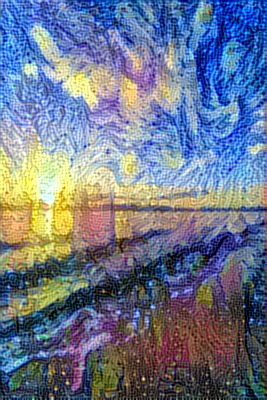風格遷移是一種很帥、但其實概念蠻優雅的技術:
把一張圖片的內容,配上另一張圖片的風格,生出一張既保留原始場景、又帶有名畫或特定質感的新圖。想像:把你家的街景照,畫成梵谷、莫內或浮世繪版本。
風格遷移迷人的地方在於,它做的不是「套濾鏡」,而是把圖片拆成兩件事再組回來:內容和風格。傳統濾鏡只是整張圖一起調色加效果,風格遷移則是先從內容圖取出場景結構與物體位置(房子、人、樹在哪),再從風格圖學紋理、筆觸、顏色與光影氛圍,最後生成一張同時滿足「長得像原場景」又「有指定畫風」的新圖片。這是靠 CNN 不同層次的特徵來做到的:淺層負責內容輪廓,深層負責風格特徵,我們不重訓模型,而是借用這些中間層輸出作為描述子。
三、內容損失:生成圖要像「原圖的樣子」
我們希望生成圖的 內容 跟內容圖接近,例如建築位置、人物輪廓還認得出來。
做法是:
1.把內容圖和生成圖都丟進同一個 CNN。
2.在某個中間層(例如 VGG 的 conv4_2)取出 feature map。
3.計算兩者 feature map 的差異(通常是歐氏距離 / MSE)。
4.Content Loss越小,代表生成圖的結構越接近原內容。
在內容部分,我們會把內容圖與生成圖丟進同一個 CNN,選定像 VGG 的 conv4_2 這類中間層作為內容特徵,計算兩者特徵圖的差異(例如用 MSE)當作內容損失(Content Loss)。這個值越小,代表生成圖的結構越接近原圖:房子還在原來的位置、人還認得出來,只是畫風被換成了另一種風格。
關鍵工具:Gram 矩陣(Gram Matrix)
步驟:
1對風格圖,取出多個層的 feature maps(例如 conv1_1, conv2_1, ...)。
2對每個層的 feature map,算出通道與通道之間的相關性 → 得到 Gram 矩陣。
3對生成圖做一樣的事。
4比較兩者 Gram 矩陣的差(MSE)
💻 實作流程 (我使用的是colab 作為練習)
程式碼:圖片路徑與尺寸設定
在這個實作中,內容圖片是 picture.jfif,風格圖片是梵谷的《星夜》(starry_night.jpeg)。
from tensorflow import keras
import numpy as np
# 內容圖片與風格圖片路徑
base_image_path='/content/drive/MyDrive/Paint/picture.jfif'
style_reference_image_path='/content/drive/MyDrive/Paint/starry_night.jpeg'
# 定義目標尺寸(將圖片高度固定為 400 像素)
original_width,original_height = keras.utils.load_img(base_image_path).size
img_height = 400
img_width = round(original_width * img_height / original_height)
圖片預處理與後處理
這是確保圖片格式符合 VGG-19 模型輸入要求的重要步驟。
def preprocess_image(image_path):
# 載入圖片並縮放至目標尺寸
img = keras.utils. load_img(
image_path, target_size=(img_height, img_width))
img= keras.utils.img_to_array(img)
# 增加批次維度 (batch dimension)
img= np. expand_dims (img, axis=0)
# 使用 VGG19 內建的預處理(例如,中心化和 BGR 轉換)
img= keras.applications.vgg19.preprocess_input(img)
return img
def deprocess_image(img):
# 移除批次維度
img = img.reshape((img_height,img_width,3))
# 還原 VGG19 預處理時減去的平均值
img[:,:,0] += 103.939
img[:,:,1] += 116.779
img[:,:,2] += 123.68
# 將 BGR 轉換回 RGB
img =img[:, :, ::-1]
# 裁剪像素值到 [0, 255] 範圍並轉換為整數
img= np.clip(img,0,255).astype("uint8")
return img
model = keras.applications.vgg19.VGG19(weights="imagenet",include_top=False)
# 創建一個字典,將層名稱映射到其輸出張量
outputs_dict = dict([(layer.name, layer.output) for layer in model.layers])
# 創建特徵提取器模型:輸入為 VGG19 輸入,輸出為指定層的輸出
feature_extractor = keras.Model(inputs=model.inputs,outputs=outputs_dict)
程式碼:內容損失(Content Loss)
內容損失使用內容圖片和生成圖片在 CNN 某個中間層的特徵圖上的歐氏距離。
import tensorflow as tf
def content_loss (base_img, combination_img):
# 計算特徵圖的平方差之和
return tf.reduce_sum(tf.square(combination_img - base_img))
風格損失(Style Loss)與 Gram 矩陣
風格特徵由 Gram 矩陣(特徵圖向量之間的相關性)來捕捉。風格損失是兩張圖片的 Gram 矩陣之間的距離。
def gram_matrix(x):
# 將特徵圖轉換為 (C, H*W) 的矩陣
x =tf.transpose(x,(2,0,1))
features = tf. reshape(x,(tf.shape(x)[0], -1))
# Gram 矩陣 = features 乘以 features 的轉置
gram = tf.matmul(features,tf.transpose(features))
return gram
def style_loss(style_img,combination_img):
S = gram_matrix(style_img)
C = gram_matrix(combination_img)
channels = 3
size = img_height * img_width
# 風格損失是 Gram 矩陣的平方差之和,並進行歸一化
return tf.reduce_sum( tf.square(S - C))/(4.0 * (channels **2) * (size ** 2))
總變差損失(Total Variation Loss)
總變差損失是一種**正規化(Regularization)**項,用於鼓勵生成圖片具有空間上的連續性,減少圖片中不自然的噪點。
def total_variation_loss(x):
# 計算水平方向的像素差平方
a= tf.square(
x[:,:img_height - 1,: img_width - 1,:]-x[:,1:,:img_width - 1,:]
)
# 計算垂直方向的像素差平方
b= tf.square(
x[:,: img_height- 1,: img_width- 1,:]-x[:, : img_height- 1, 1:, :]
)
# L1.25 範數
return tf.reduce_sum(tf.pow(a + b, 1.25))
style_layer_names = [
"block1_conv1",
"block2_conv1",
"block3_conv1",
"block4_conv1",
"block5_conv1",
] # 使用 VGG19 的多個淺層到深層來捕捉風格
content_layer_name = "block5_conv2" # 使用單個深層來捕捉內容
# 權重配置(用於調整內容、風格和噪點的影響程度)
total_variation_weight = 1e-6
style_weight = 1e-6
content_weight = 2.5e-8
總損失計算函式
這個函式負責將所有損失項加權組合起來。
def compute_loss (combination_image, base_image, style_reference_image):
# 將三個圖片堆疊起來一次性送入模型,以提高效率
input_tensor = tf.concat(
[base_image, style_reference_image,combination_image], axis=0
)
features = feature_extractor (input_tensor)
loss = tf.zeros (shape=())
# 1. 內容損失計算
layer_features = features[content_layer_name]
base_image_features = layer_features [0,:,:,:] # 第一個圖(內容圖)的特徵
combination_features = layer_features [2, :, :, :] # 第三個圖(生成圖)的特徵
loss = loss + content_weight * content_loss(
base_image_features, combination_features
)
# 2. 風格損失計算(遍歷所有風格層)
for layer_name in style_layer_names:
layer_features = features [layer_name]
style_reference_features = layer_features [1, :, :,:] # 第二個圖(風格圖)的特徵
combination_features = layer_features [2, :, :,:]
style_loss_value = style_loss(
style_reference_features, combination_features)
# 將總風格權重平均分配給每個風格層
loss += (style_weight / len(style_layer_names)) * style_loss_value
# 3. 總變差損失
loss += total_variation_weight * total_variation_loss(combination_image)
return loss
@tf.function
def compute_loss_and_grads(combination_image, base_image, style_reference_image) :
with tf.GradientTape() as tape:
# 紀錄計算過程,以便計算梯度
loss = compute_loss (combination_image, base_image, style_reference_image)
# 計算損失對 combination_image 的梯度
grads = tape.gradient (loss, combination_image)
return loss, grads
# 設定優化器:帶有指數衰減學習率的 SGD
optimizer = keras. optimizers.SGD(
keras.optimizers.schedules.ExponentialDecay(
initial_learning_rate=100.0, decay_steps=100, decay_rate=0.96
)
)
程式碼:主迭代迴圈
這是風格遷移的核心過程,圖片的像素值在這裡被逐步優化。
# 準備輸入圖片並將生成圖片初始化為內容圖片
base_image = preprocess_image(base_image_path)
style_reference_image = preprocess_image(style_reference_image_path)
# 將生成圖片宣告為 tf.Variable,因為它的值將在訓練中更新
combination_image = tf.Variable(preprocess_image(base_image_path))
iterations = 4000 # 總迭代次數
for i in range(1, iterations + 1):
print('iterations:{0}'.format(i))
# 1. 計算當前損失和梯度
loss, grads = compute_loss_and_grads(
combination_image, base_image, style_reference_image
)
# 2. 應用梯度,更新圖片像素
optimizer.apply_gradients([(grads, combination_image)])
# 3. 每 100 次迭代保存並顯示進度
if i%100 == 0:
print(f"Iteration{i}: loss={loss:.2f}")
img = deprocess_image(combination_image.numpy())
fname = f"combination_image_at_iteration_{i}.png"
keras.utils.save_img(fname, img)
這樣就完成一個小小的實作了
